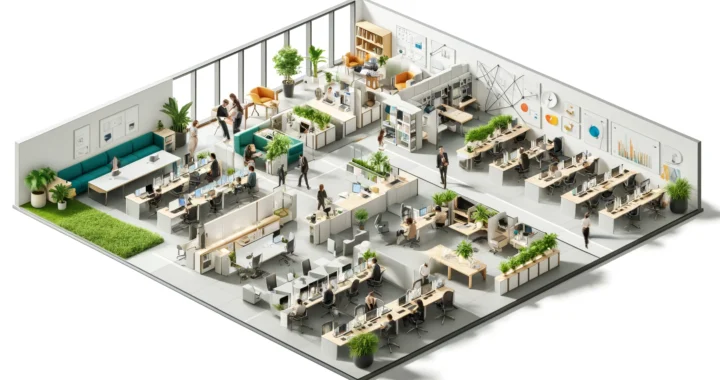Space utilization is not merely about managing square footage; it’s a strategic endeavor that plays a pivotal role in modern business operations. In today’s dynamic work environment, the efficient use of office space is more than a necessity—it’s a catalyst for organizational success. Effective space utilization goes beyond mere physical arrangements, influencing everything from operational costs to employee productivity and morale. Businesses that master the art of optimizing their workspace can achieve a delicate balance, creating environments that foster innovation, collaboration, and well-being. This equilibrium between the tangible aspects of office square footage and the intangible elements of worker satisfaction and efficiency underscores the essence of space utilization. By recognizing and acting on the potential of every square inch, companies can cultivate a workspace that not only meets the immediate needs of their workforce but also adapts to the evolving landscape of work practices.
The Importance of Space Utilization
In the ever-evolving landscape of the corporate world, space utilization emerges as a critical consideration for businesses aiming to navigate the complexities of modern work patterns. The shift towards more flexible and adaptable work environments necessitates a reevaluation of how physical spaces are designed and utilized. This change is driven by a growing recognition that the strategic use of office space can lead to significant cost savings and a more dynamic, responsive business model. By optimizing space, companies can reduce unnecessary real estate expenses and allocate resources more effectively, enhancing overall operational efficiency.
Moreover, the impact of well-planned space utilization extends beyond the financial aspects to profoundly influence employee well-being and productivity. A workspace that aligns with the needs and preferences of its users can foster a more engaging and motivating environment. Employees thrive in spaces that are thoughtfully designed to support various work styles and activities, from collaborative projects to individual tasks requiring concentration and quiet. Thus, effective space utilization is not just a matter of economic prudence but a strategic approach to creating work environments that promote health, satisfaction, and peak performance, embodying the core principle of efficiency in every aspect of its execution.
Effective Strategies for Space Maximization
To maximize office space efficiently, adopting a multifaceted approach that incorporates reconfiguring layouts, embracing flexible work practices, and leveraging technology is essential. Reconfiguring office layouts can dramatically transform the use of space. By moving away from traditional cubicle-heavy environments to more open, modular layouts, organizations can create versatile areas that adapt to various work activities, from collaborative brainstorming sessions to quiet, focused work.
Flexible work practices are another cornerstone of modern space utilization strategies. With the rise of remote work and hybrid models, companies no longer need to maintain a one-desk-per-employee policy. Instead, implementing hot-decking or activity-based workstations allows for a more dynamic use of office space, accommodating fluctuating in-office populations without wasting valuable real estate. This flexibility can lead to significant cost savings and contribute to a more vibrant, energy-filled workplace.
Technology plays a pivotal role in enhancing space utilization. Advanced management software and analytical tools can track space usage, identify underutilized areas, and provide insights for optimization. Sensor technology and data analytics can monitor occupancy levels in real-time, facilitating informed decisions about space re-allocation or adjustments. Furthermore, integrating these technologies with mobile applications enables employees to book workspaces and meeting rooms efficiently, optimizing the daily use of office resources.
These strategies, when combined, contribute to creating a dynamic and productive work environment. They enable businesses to respond swiftly to changing workforce needs, promote collaboration, and ensure that every square foot of office space is used optimally. By focusing on flexibility, adaptability, and data-driven decisions, organizations can foster an office ecosystem that not only maximizes spatial efficiency but also enhances employee engagement and productivity. In essence, the deployment of these strategic measures transforms traditional office spaces into agile, responsive environments that support and stimulate the modern workforce.
Tips for Small Office Spaces
Maximizing small office spaces requires smart, creative strategies to make the most of the available area while fostering a productive and welcoming environment. Creating an illusion of space is the first step. This can be achieved through the use of light colors on walls, strategic lighting, and mirrors to reflect natural light, making the area feel larger and more open. The layout should be planned to ensure free movement and minimize clutter, giving the impression of a more expansive space.
Multifunctional furniture is a game-changer in small offices. Items that serve dual purposes, such as desks that double as storage units or meeting tables that can be folded away when not in use, help conserve space while maintaining functionality. This flexibility is crucial in a small office environment, as it allows the space to adapt to different needs and activities without requiring additional square footage.
Optimizing storage is another key aspect. Vertical storage solutions, like wall-mounted shelves and tall, narrow cabinets, can store office essentials without occupying much floor space. Utilizing under-desk areas with mobile pedestals or built-in drawers can also help keep the workspace tidy and organized.
Thoughtful design is essential in a small office to enhance productivity and create an inviting atmosphere. Every element, from the color palette to the furniture layout, should be chosen with the goal of making the space feel open, airy, and conducive to work. By carefully considering these aspects, small office spaces can be transformed into efficient, enjoyable places to work, proving that a limited area need not be a barrier to creating a dynamic and effective work environment.
Tools and Technologies
In the realm of office space management, advanced tools and technologies play a pivotal role in enhancing efficiency and optimizing the use of space. Space planning software and analytics platforms stand out as essential tools for modern businesses seeking to maximize their office layout. These technologies offer detailed insights into space usage patterns, enabling facility managers to understand how different areas of the office are utilized throughout the workday.
Space planning software, for example, allows organizations to create and test various layout scenarios virtually before implementing any physical changes. This can significantly reduce the risk of costly missteps and ensure that the final layout is both functional and efficient. Analytics platforms take this a step further by collecting and analyzing data on how employees interact with their workspace. This data can reveal trends, such as which meeting rooms are most frequently used or how hot-desking arrangements are functioning in practice, providing a solid basis for making informed decisions.
By leveraging these tools, companies can move beyond guesswork and base their space optimization strategies on concrete data. This leads to more effective use of office space, with adjustments and improvements that are directly informed by actual usage patterns. In turn, this strategic approach helps in creating a more dynamic, responsive, and ultimately productive work environment.
Challenges and Solutions
Navigating the intricacies of office space utilization presents several challenges, particularly in adapting to hybrid work models and managing space in high-demand areas. Hybrid work environments, which blend remote and in-office work, necessitate a flexible and dynamic approach to space planning. The fluctuating number of on-site employees can lead to underused spaces on some days and a shortage of resources on others. To address this, companies can implement reservation systems for workstations and meeting rooms, ensuring that space is allocated efficiently and can adapt to daily needs.
Managing space in high-demand areas requires strategic planning to avoid overcrowding and ensure that all employees have access to the necessary resources. Solutions such as staggered work hours or designated zones for different teams can help distribute the use of space evenly throughout the day and week. Additionally, investing in real-time occupancy monitoring tools can provide valuable insights into space usage patterns, enabling managers to make proactive adjustments.
Best practices for overcoming these challenges include regular reviews of space utilization data to identify trends and areas for improvement. Engaging with employees to gather feedback on their workspace experience can also yield actionable insights for refining the office layout and amenities. Furthermore, understanding the responsibilities of commercial property owners and managers is crucial in aligning office space utilization strategies with broader property management objectives, ensuring a cohesive approach to creating an efficient and effective work environment.
Future Trends in Office Space Utilization
The landscape of office design and space management is rapidly evolving, influenced by trends such as remote work, technological advancements, and changing employee preferences. The future of workspace optimization and management is likely to be shaped by these dynamic factors, presenting both challenges and opportunities.
Remote work has already transformed traditional office environments, leading to a decreased need for permanent workstations and an increased demand for flexible, collaborative spaces. This shift is expected to continue, with offices becoming hubs for collaboration and social interaction rather than daily workspaces.
Technological advancements, particularly in the realm of AI and IoT, are set to further revolutionize office space utilization. Smart office technologies will enable more efficient use of space, with features like automated climate control, occupancy sensing, and real-time space allocation. These tools will help address the challenges of managing fluctuating office attendance and optimizing the use of space.
Employee preferences are also steering the direction of office design, with a growing emphasis on sustainability, well-being, and flexibility. Future office spaces will likely be designed with a focus on creating healthy, inspiring environments that accommodate a range of working styles and activities.
As these trends converge, they will redefine the principles of office space management, leading to more adaptive, responsive, and employee-centered workplaces.
Conclusion
In conclusion, strategic space utilization is vital for modern businesses, balancing cost-efficiency with employee productivity and well-being. The key points discussed underline the importance of adaptable layouts, embracing technology, and considering employee needs to optimize office spaces effectively. As workplace dynamics continue to evolve, especially with shifts towards hybrid models and technological integration, continuous adaptation becomes crucial. Businesses must proactively manage their office spaces, using the insights and strategies explored in this article, to cultivate a work environment that is not only productive but also sustainable and conducive to future growth.

